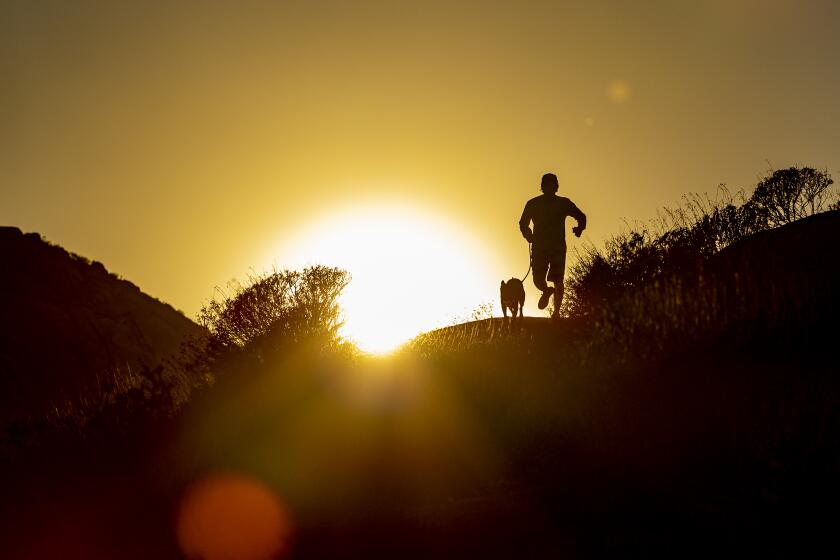Fire Crews Douse Hot Spots, Start Packing Up
- Share via
FILLMORE — Part tedious but still plenty dangerous, the final hours of the Grand fire wound down Wednesday with crack teams of firefighters being airlifted into rough mountainous country to douse the remaining hot spots while crews at the command center began dismantling tents, packing up unneeded supplies and enjoying the luxury of their first showers in days.
The final tally of the season’s first--and unexpectedly early--wildfire was 10,925 acres burned from Fillmore to the edge of Santa Paula, with an estimated cost of $2 million. By evening, the number of firefighters on the scene had tapered to about 400, down from Monday’s peak of about 2,000 personnel from as far away as Montana.
A spokesman said the fire was almost contained by late Wednesday afternoon, except for patches still smoldering in remote areas. Full containment is expected by 6 p.m. today.
“The last 20% is real ugly,” said public information officer Charlie Johnson. “It’s mountain goat territory.”
Two experienced teams, the Los Padres Hot Shots and a group from Montana, were sent up San Cayetano Mountain in helicopters Wednesday morning, with the warning to go slowly and be extremely careful.
“They were told this is not a hurry-up job,” Johnson said. “This is a very dangerous job.”
Though the heat and smoke that had complicated firefighters’ efforts early this week eased off Wednesday, air quality remained poor, due to the same Santa Ana wind conditions that caused the Grand fire to spread rapidly Sunday. Offshore winds pushed pollution from the Santa Anas back onto land, causing unhealthful violations of state ozone standards in Simi Valley, Ojai and Thousand Oaks.
On Wednesday, a crew from Ventura County’s Hazardous Materials Response Team returned to the fire’s believed origin point at an oil field off Squaw Flat Road, and examined the area where traces of PCB contamination had been discovered in an electrical transformer earlier in the day.
Johnson said the initial tests of the transformer had been negative for PCBs, but that a second test showed traces of the chemicals. A warning sign was posted at the command center Wednesday telling firefighters to report any possible exposure to the carcinogenic material. But Johnson downplayed the danger.
“Our belief is that the only ones exposed were the investigators,” he said, noting that they were all dressed in protective gear and had not arrived on the scene until any possibility of contaminated smoke from the PCBs had passed.
A crew of soil experts, hydrologists, foresters and an archeologist ventured onto the edge of the burned territory Wednesday afternoon to begin mapping the fire’s environmental impact. Working with Ventura County Flood Control, the Forest Service hopes to have a report by Monday outlining the needs for watershed rehabilitation.
“I don’t think the impacts on the national forest lands are going to be too big,” said group leader George Garcia, a resource officer with Los Padres National Forest. “But what does happen is going to affect the people below, the farmers and the ranchers. As they say, everything goes downhill and downstream.”
Rehabilitation may include clearing stream courses of fire debris and reseeding areas where the fire burned most intensely.
“It burned a lot over there,” said forest soil scientist Barry Cohn, pointing to a hillside dusted with white ash. “The white ash means it burned hot, consuming all the vegetative material.”
Cohn carefully noted the area with a pencil mark on a topographic map. Using footwork and aerial photographs over the next few days, experts will map the whole burn area.
Back at the command post at Fillmore’s Shiells Park, the intense action of the four-day battle against the Grand fire finally calmed long enough to give logistics coordinator X Kellogg time to take his first hot shower since he arrived on the scene Sunday night.
“I couldn’t stand myself,” Kellogg said with a laugh.
All around him, tents were being packed up, trucks were being loaded and firefighters were saying farewells.
“We’re getting ready to shut it down,” Kellogg said. “By Thursday night, it’ll be history.”
Stacks of cardboard boxes filled with supplies were being tossed into the back of a truck, headed back to a warehouse in Ontario. About $290,000 worth of supplies, including batteries, safety equipment, sleeping bags, headlamps and canteens had been ordered for the disaster, but supply officer Thomas Kaucher said needs had been overestimated.
“We send a lot of this stuff back,” Kaucher said. “Our total cost is going to end up around $50,000 to $70,000 for supplies.”
Wednesday’s lull gave food supply officer Michael Mattia time to light up a cigar and contemplate how many meals and drinks he had helped distribute since the fire began Sunday. More than 10,000 sack lunches, 1,500 cases of water, 1,200 more of juice and about 3,000 dinners were dispensed. Only 379 were expected for dinner Wednesday night.
More to Read
Sign up for Essential California
The most important California stories and recommendations in your inbox every morning.
You may occasionally receive promotional content from the Los Angeles Times.













